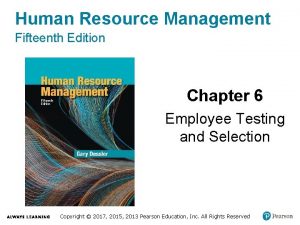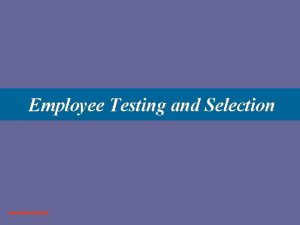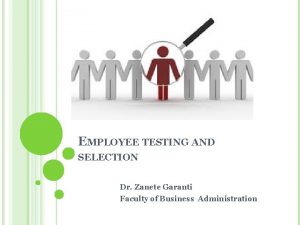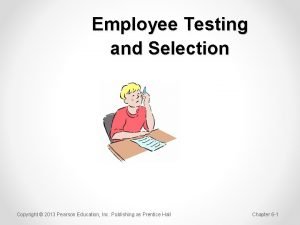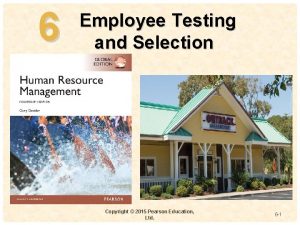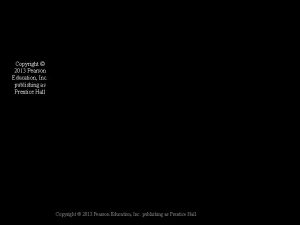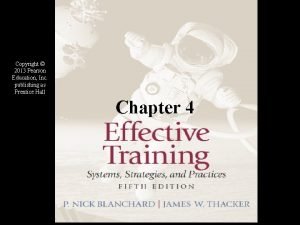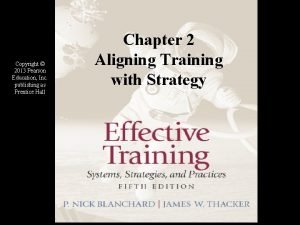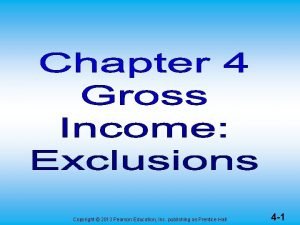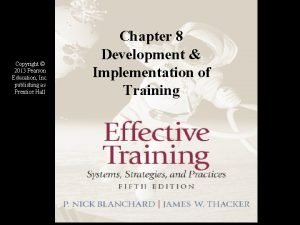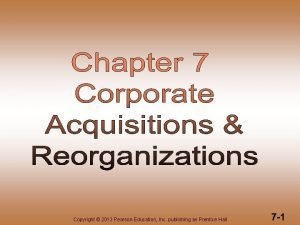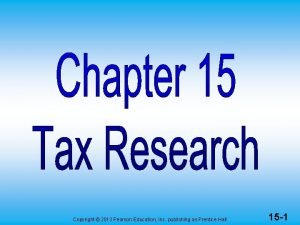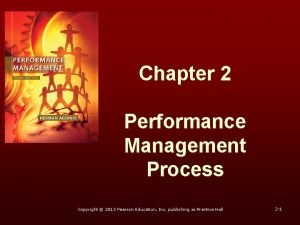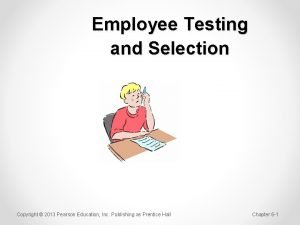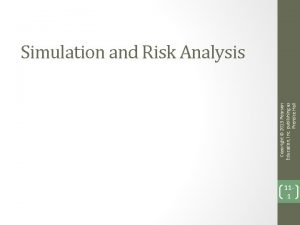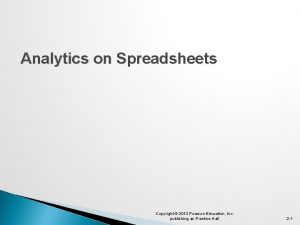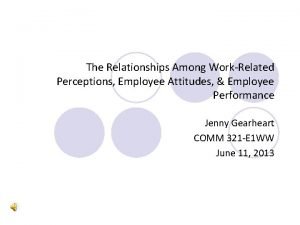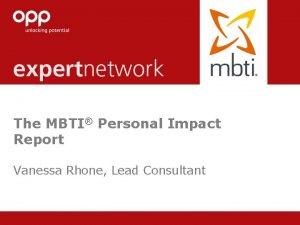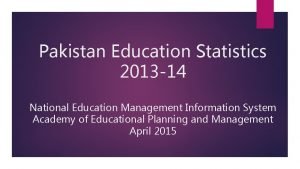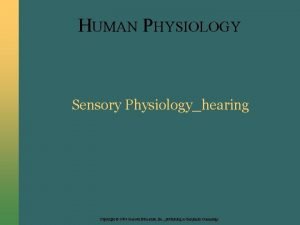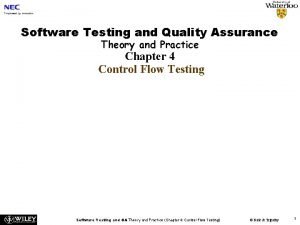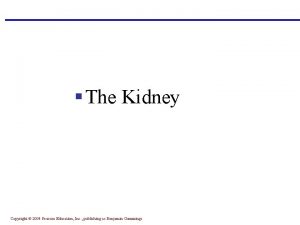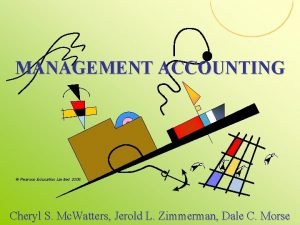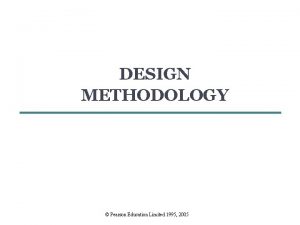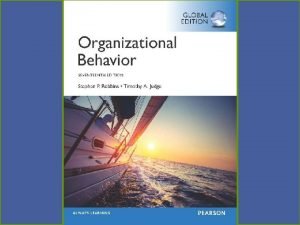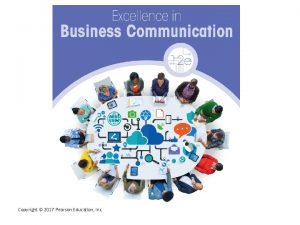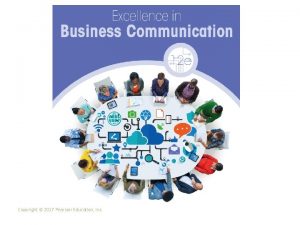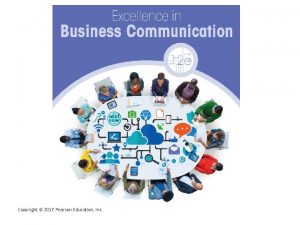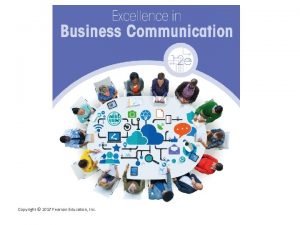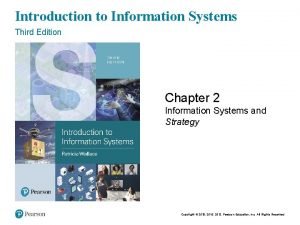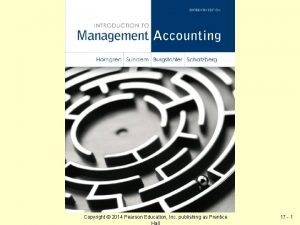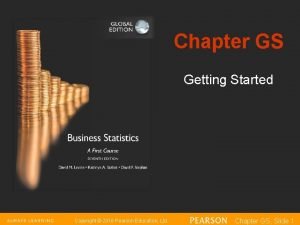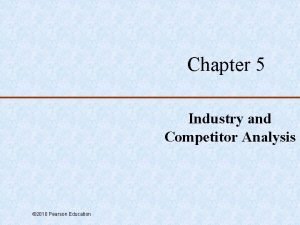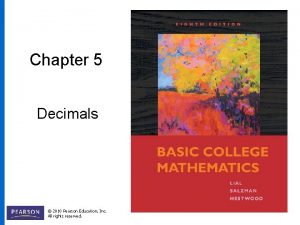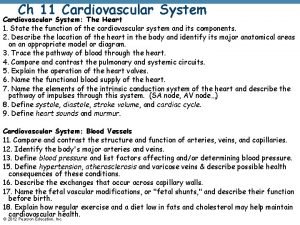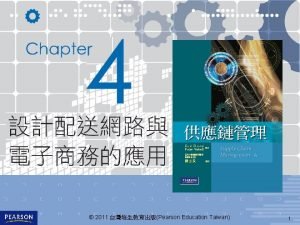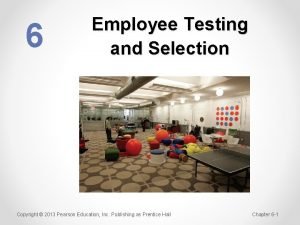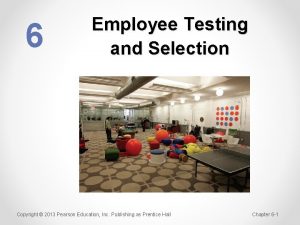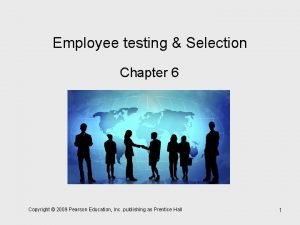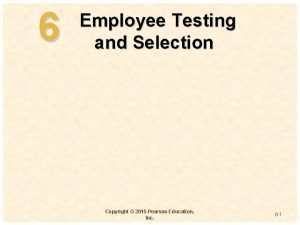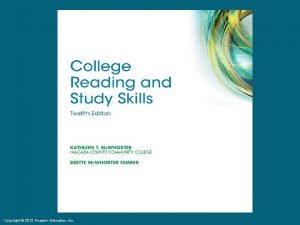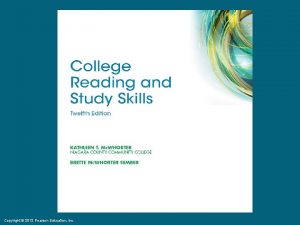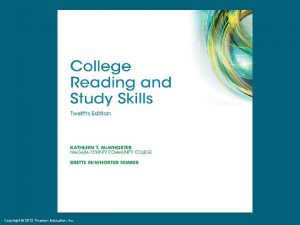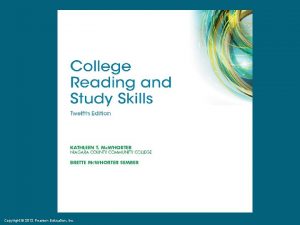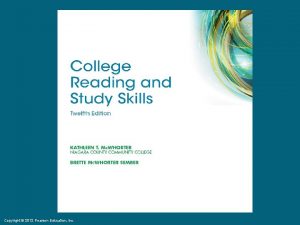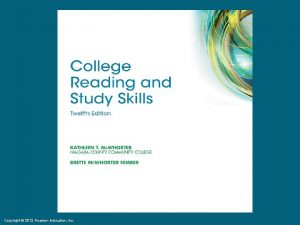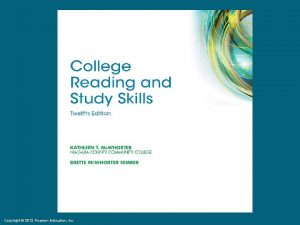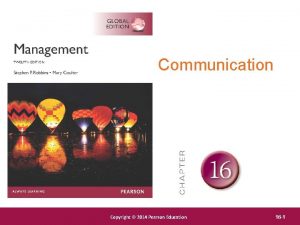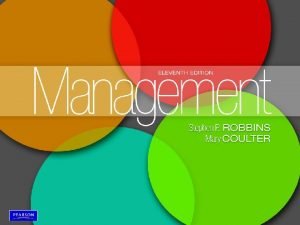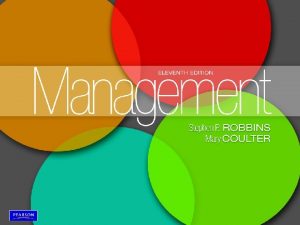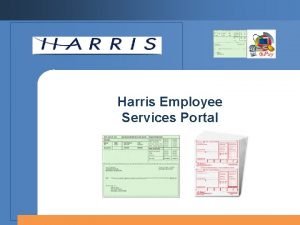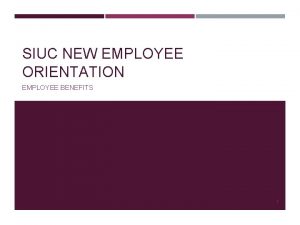Employee Testing and Selection Copyright 2013 Pearson Education

























































































































- Slides: 121

Employee Testing and Selection Copyright © 2013 Pearson Education, Inc. Publishing as Prentice Hall Chapter 6 -1

Selection tools • This lecture is designed to explain how to use various tools to select the best candidates for the job. • The main topics we’ll cover include selection, testing, background and reference checks, ethical and legal questions, types of tests, and work samples and simulations. Copyright © 2013 Pearson Education, Inc. Publishing as Prentice Hall Chapter 6 -2

Learning Objectives 1. Explain what is meant by reliability and validity. 2. Explain how you would go about validating a test. 3. Cite and illustrate our testing guidelines. 4. Give examples of some of the ethical and legal considerations in testing. Copyright © 2013 Pearson Education, Inc. Publishing as Prentice Hall Chapter 6 -3

Learning Objectives 5. List eight tests you could use for employee selection, and how you would use them. 6. Give two examples of work sample/simulation tests. 7. Give examples of some of the ethical and legal considerations in testing. Copyright © 2013 Pearson Education, Inc. Publishing as Prentice Hall Chapter 6 -4

But firstly today's Reflective THEME • Reflective theme 3 • Q. “What exactly is the war for talent? Why is it important for all organizations? Copyright © 2013 Pearson Education, Inc. Publishing as Prentice Hall Chapter 4 -5

What is Talent Management? • Talent management is the goal-oriented and integrated process of planning, recruiting, developing, managing, and compensating employees. • Five things set talent management apart from other recruiting, training, etc. activities. • Talent management tasks are parts of a single interrelated process. Copyright © 2013 Pearson Education, Inc. Publishing as Prentice Hall Chapter 4 -6

Talent management • Talent management decisions are goal-directed. • Puts the emphasis on role the same “profile” of competencies, traits, knowledge and experience formulating recruitment plans for a job as you do for making selection, training, appraisal, and payment decisions for it. • Actively segment and manage employees. • Integrate/coordinate all the talent management functions. Copyright © 2013 Pearson Education, Inc. Publishing as Prentice Hall Chapter 6 -7

Why Careful Selection is Important • • Performance Cost Legal obligations Person and job/organization fit Copyright © 2013 Pearson Education, Inc. Publishing as Prentice Hall Chapter 6 -8

Careful selection • Careful selection is important for three main reasons: performance, costs, and legal obligations. • First, your own performance always depends on your subordinates. • Second, it is important because it’s costly to recruit and hire employees. The opening story in chapter 6 of the set text indicated, Google’s hiring process was streamlined due to the amount of time taken for interviews. Time spent by employees equates to the costs of not being productive in their jobs. Copyright © 2013 Pearson Education, Inc. Publishing as Prentice Hall Chapter 6 -9

Careful Selection • Third, it’s important because mismanaging hiring has legal consequences. • Person-job fit refers to identifying the knowledge, skills, abilities (KSAs), and competencies that are central to performing the job. Then we must match the KSAs to the prospective employee’s knowledge, skills, abilities, and competencies. Copyright © 2013 Pearson Education, Inc. Publishing as Prentice Hall Chapter 6 -10

What is meant by reliability and validity ? Copyright © 2013 Pearson Education, Inc. Publishing as Prentice Hall Chapter 6 -11

Basic Testing Concepts • Reliability • Validity o Criterion validity o Content validity o Construct validity Copyright © 2013 Pearson Education, Inc. Publishing as Prentice Hall Chapter 6 -12

A RELIABLE TEST ? • A test is basically a sample of a person’s behavior. Using a test (or any selection tool) assumes the tool is both reliable and valid. • A reliable test is one that yields consistent scores when a person takes two alternate forms of the test or takes the same test on two or more different occasions. Copyright © 2013 Pearson Education, Inc. Publishing as Prentice Hall Chapter 6 -13

Validity • Validity tells you whether the test is measuring what you think it’s supposed to be measuring. Now, let’s discuss three types of validity. • Criterion validity involves demonstrating statistically there is a relationship between scores on a selection procedure and the job performance of a sample of workers. It means showing that workers who do well on the job also do well on the test. Copyright © 2013 Pearson Education, Inc. Publishing as Prentice Hall Chapter 6 -14

Content & Construct Validity • Content validity shows that the content of a selection procedure is representative of important aspects of performance on the job. Constructs represent an underlying human trait or characteristic such as honesty. Construct validity demonstrates that a selection procedure measures a construct and that the construct is important for successful job performance. Copyright © 2013 Pearson Education, Inc. Publishing as Prentice Hall Chapter 6 -15

Measuring Reliability • Measuring reliability generally involves comparing two measures that assess the same thing. It is typical to judge a test’s reliability in terms of a correlation coefficient (in this case, a reliability coefficient). Such a coefficient shows the degree to which the two measures (say, a test score one day and a test score the next day) are related. Copyright © 2013 Pearson Education, Inc. Publishing as Prentice Hall Chapter 6 -16

A selection Test • A selection test must be valid. Without proof of validity, there is no logical or legally permissible reason to continue using it to screen job applicants. Remember that a valid test is one that measures what you intend to measure. A word processing test, for example, clearly would be a valid test of keyboarding skills. Copyright © 2013 Pearson Education, Inc. Publishing as Prentice Hall Chapter 6 -17

Review • Reliability = consistency • Validity = measuring what you intend to measure Copyright © 2013 Pearson Education, Inc. Publishing as Prentice Hall Chapter 6 -18

How to go about validating a test Copyright © 2013 Pearson Education, Inc. Publishing as Prentice Hall Chapter 6 -19

Evidence • In order for a selection test to be useful, you need evidence that scores on the test relate in a predictable way to performance on the job. Copyright © 2013 Pearson Education, Inc. Publishing as Prentice Hall Chapter 6 -20

Evidence-Based HR: How to Validate a Test • • • Analyze Choose Administer Relate Cross-validate Copyright © 2013 Pearson Education, Inc. Publishing as Prentice Hall Chapter 6 -21

Job analysis 1. First, analyze the job and write job descriptions and job specifications. Your goal is to specify the human traits and skills (predictors) you believe are required for job performance. 2. Next, decide how to test for the predictors and choose the tests. You usually will base this choice on experience, previous research, and “best guesses. ” You likely will choose several tests and combine them into a test battery. Copyright © 2013 Pearson Education, Inc. Publishing as Prentice Hall Chapter 6 -22

Options 1. One option is to administer the tests to employees currently on the job. You then compare their test scores with their current performance; this is concurrent (at the same time) validation. Its main advantage is that data on performance are readily available. Predictive validation is the second and more dependable way to validate a test. 2. Here you administer the test to applicants before you hire them. 3. Then hire these applicants using only existing selection techniques (such as interviews). You would not use the results of the new tests. After they have been on the job for some time, measure their performance and compare it to their earlier test scores. Copyright © 2013 Pearson Education, Inc. Publishing as Prentice Hall Chapter 6 -23

Cross validation 1. Finally, before using the test, you may want to check it by “cross-validating”—in other words, by again performing steps 3 and 4 on a new sample of employees. 2. Next, determine if there is a significant relationship between test scores (the predictor) and performance (the criterion). The usual way to do this is to use statistical testing. Copyright © 2013 Pearson Education, Inc. Publishing as Prentice Hall Chapter 6 -24

Review Copyright © 2013 Pearson Education, Inc. Publishing as Prentice Hall Chapter 6 -25

Validation Validating a test does not need to be complicated, but it does take time and careful planning. Analyze the job and write job descriptions and specifications. Then choose how to test for predictors. Let experience, previous research, and “best guesses” guide you. You likely will choose several tests and combine them into a test battery. Copyright © 2013 Pearson Education, Inc. Publishing as Prentice Hall Chapter 6 -26

Administering the test • To administer the test properly, consider using it with your best performing employees who currently hold positions you seek to fill. • Consider administering the test to applicants before you hire them. • Then hire these applicants using your usual selection techniques (such as interviews) but not the results of the new tests. • After they have been on the job for some time, measure their performance and compare it to their earlier test scores. Copyright © 2013 Pearson Education, Inc. Publishing as Prentice Hall Chapter 6 -27

Next, determine if there is a significant relationship between test scores and performance. The usual way to do this is to use statistical analysis. Copyright © 2013 Pearson Education, Inc. Publishing as Prentice Hall Chapter 6 -28

Cite and illustrate our testing guidelines Copyright © 2013 Pearson Education, Inc. Publishing as Prentice Hall Chapter 6 -29

Evidence-Based HR: Test Validation Issues • • Who scores the test? Bias Utility analysis Validity generalization Copyright © 2013 Pearson Education, Inc. Publishing as Prentice Hall Chapter 6 -30

Scoring Tests • In many cases, certain tests are scored and interpreted by outside professionals. The results are then provided to the manager for consideration of whom to hire or promote. • There may be bias in how the test measures the trait it purports to measure. If test scores indicate that males perform better in verbal reasoning tasks than do females, when in fact they both perform equally well, the test is biased. • Second, “If the test used in college admissions systematically over predicts the performance of males and under predicts the performance of females, [then] that test functions as a biased predictor. ” Copyright © 2013 Pearson Education, Inc. Publishing as Prentice Hall Chapter 6 -31

Utility analysis • Utility analysis simply answers the question, Does it pay to use a given test in a particular situation? In other words, if you use a specific test, will the quality of individuals selected be better than if you had not used the test? • Validity generalization helps determine if a test is valid in one situation, will it be so in others. Or, will the test need to be re-validated? Especially for smaller employers, properly generalizing the validity of a test can be a business lifesaver. Copyright © 2013 Pearson Education, Inc. Publishing as Prentice Hall Chapter 6 -32

Ethical and legal considerations in testing Copyright © 2013 Pearson Education, Inc. Publishing as Prentice Hall Chapter 6 -33

Evidence-Based HR: Test Validation Other Issues • • Individual rights and test security Privacy issues Using tests at work Computerized and online testing Copyright © 2013 Pearson Education, Inc. Publishing as Prentice Hall Chapter 6 -34

Expectation of test takers • Test takers have rights to privacy and feedback under the American Psychological Association’s (APA) standards. Test takers (your potential future employees) have the right to expect: • Confidentiality of results • An informed consent opportunity • Only people qualified to interpret the scores will have access to them • The test is fair for all some tests adapt to the previous answers provided by the test taker, creating a one-off “custom” test. Copyright © 2013 Pearson Education, Inc. Publishing as Prentice Hall Chapter 6 -35

Privacy In terms of privacy, common sense suggests that managers should keep their knowledge of employees’ test results private. However, there also privacy protections embedded in U. S. and common law. Testing is used to screen in good employees and also to screen out ones that will not be successful. Copyright © 2013 Pearson Education, Inc. Publishing as Prentice Hall Chapter 6 -36

ON LINE TESTING • Computerized online testing is rapidly replacing traditional paper-and-pencil tests. In some cases, tests may be accessed via smart phones. • That is, some tests adapt to the previous answers provided by the test taker, creating a one-off “custom” test. Copyright © 2013 Pearson Education, Inc. Publishing as Prentice Hall Chapter 6 -37

Review • • Rights and security Privacy Tests at work Computerized, online testing Copyright © 2013 Pearson Education, Inc. Publishing as Prentice Hall Chapter 6 -38

RIGHTS • Remember that all employees and potential employees expect and have the right to privacy and security. • Tests at work are designed to help both the employer and employee when it comes to promotions and job changes. Note the trend today is towards more online and computer-based test taking. Such computerized procedures can help with speed and accuracy. Copyright © 2013 Pearson Education, Inc. Publishing as Prentice Hall Chapter 6 -39

Tests for employee selection, and how you would use them Copyright © 2013 Pearson Education, Inc. Publishing as Prentice Hall Chapter 6 -40

Classification • We can conveniently classify tests according to whether they measure cognitive (mental) abilities, motor and physical abilities, personality and interests, or achievement. Copyright © 2013 Pearson Education, Inc. Publishing as Prentice Hall Chapter 6 -41

Types of Tests • Cognitive abilities o Intelligence tests o Specific cognitive abilities • • Motor & physical abilities Measuring personality Interest inventories Achievement tests Copyright © 2013 Pearson Education, Inc. Publishing as Prentice Hall Chapter 6 -42

Cognitive &Intelligence tests • Cognitive tests include testing general reasoning ability or intelligence. In addition, they include tests of specific mental abilities such as memory or inductive reasoning. • Intelligence tests are tests of general intellectual abilities. They measure a range of abilities, including memory, vocabulary, verbal fluency, and numerical ability. There also measures of specific cognitive abilities, such as deductive reasoning, verbal comprehension, memory, and numerical ability. Copyright © 2013 Pearson Education, Inc. Publishing as Prentice Hall Chapter 6 -43

Tests • You also might need to measure motor abilities, such as finger dexterity, manual dexterity, and (if hiring pilots) reaction time. • Personality tests measure basic aspects of an applicant’s personality. You should be a bit cautious about personality tests, however. In some cases, the tests may be somewhat difficult to interpret. Legal challenges also may present difficulties. • Finally, some doubt exists as to whether self-reporting on a personality test can predict performance correctly. Copyright © 2013 Pearson Education, Inc. Publishing as Prentice Hall Chapter 6 -44

Interest Inventories/Achievement Tests • Interest inventories compare one’s interests with those of people in various occupations. And, achievement tests measure what someone has learned. Copyright © 2013 Pearson Education, Inc. Publishing as Prentice Hall Chapter 6 -45

What do personality tests measure? • The “Big Five” • Predicting performance • Caveats Copyright © 2013 Pearson Education, Inc. Publishing as Prentice Hall Chapter 6 -46

Personality Tests Personality tests measure basic aspects of an applicant’s personality, such as introversion, stability, and motivation. Some of these tests are projective. The psychologist presents an ambiguous stimulus (like an inkblot or clouded picture) to the person. The person then reacts to it. Other personality tests are self-reported: applicants complete themselves. Industrial psychologists often focus on the “Big Five” personality dimensions: extraversion, emotional stability/neuroticism, agreeableness, conscientiousness, and openness to experience. Copyright © 2013 Pearson Education, Inc. Publishing as Prentice Hall Chapter 6 -47

Personality traits • Personality traits can be predictive since they do often correlate with job performance. Other traits correlate with occupational success. For example, extraversion correlates with success in sales and management jobs. However, there are three caveats. • First, projective tests are hard to interpret. An expert must analyze the test taker’s interpretations and make conclusions about his or her personality. • Second, personality tests can trigger legal challenges. • Third, some dispute that self-reported personality tests predict performance at all. Copyright © 2013 Pearson Education, Inc. Publishing as Prentice Hall Chapter 6 -48

Care needed • Be aware of what you expect from a personality test and the caveats associated with it. Nonetheless, personality tests can be a valuable source of information. Copyright © 2013 Pearson Education, Inc. Publishing as Prentice Hall Chapter 6 -49

Review • Cognitive abilities • Interests o IQ o Specific mental abilities • Motor skills • Personality • • Achievement “Big 5” Predicting Caveats o Interpretation o Legal issues o Disputing value Copyright © 2013 Pearson Education, Inc. Publishing as Prentice Hall Chapter 6 -50

Cognitive Tests • Cognitive tests include tests of general reasoning ability and tests of specific mental abilities. • Intelligence tests are tests of general intellectual abilities. There also measures of specific cognitive abilities. You also might need to measure motor abilities such as reaction times for pilots. Copyright © 2013 Pearson Education, Inc. Publishing as Prentice Hall Chapter 6 -51

Personality Tests Personality tests measure basic aspects of an applicant’s personality. Interest inventories compare one’s interests with those of people in various occupations. And, achievement tests measure what someone has learned. Copyright © 2013 Pearson Education, Inc. Publishing as Prentice Hall Chapter 6 -52

The Big 5 • Industrial psychologists often focus on the “Big Five” personality dimensions: extraversion, emotional stability/neuroticism, agreeableness, conscientiousness, and openness to experience. Personality traits do often correlate with job performance. • Other traits correlate with occupational success. • However, there are three caveats: proper interpretation, legal issues, and disputes over the value of self-reporting. Copyright © 2013 Pearson Education, Inc. Publishing as Prentice Hall Chapter 6 -53

Examples of work sample/simulation tests Copyright © 2013 Pearson Education, Inc. Publishing as Prentice Hall Chapter 6 -54

Work samples • With work samples, you present candidates with situations representative of the job for which they’re applying, and evaluate their responses. Copyright © 2013 Pearson Education, Inc. Publishing as Prentice Hall Chapter 6 -55

Work samples and simulations • • Basic procedure Situational judgment tests Management assessment centers Situational testing Copyright © 2013 Pearson Education, Inc. Publishing as Prentice Hall Chapter 6 -56

Work Sampling • The basic procedure with work sampling is to select a sample of several tasks crucial to performing the job, and then test applicants on them. • Situational judgment tests are personnel tests “…designed to assess an applicant’s judgment regarding a situation encountered in the workplace. ” Situational judgment tests are effective and widely used. Copyright © 2013 Pearson Education, Inc. Publishing as Prentice Hall Chapter 6 -57

Management Assessment Centre • A management assessment center is a 2 - to 3 day simulation in which 10 to 12 candidates perform realistic management tasks such as making presentations. • The behaviors of the candidates are observed by experts who appraise each candidate’s leadership potential. • Most experts view assessment centers as effective for selecting management candidates. • However, they are quite costly in terms of money and time. Copyright © 2013 Pearson Education, Inc. Publishing as Prentice Hall Chapter 6 -58

Situational Tests • Situational tests require examinees to respond to situations found on the job. • Work sampling and some assessment center tasks fall into this category. • Some of the testing may be video-based. Copyright © 2013 Pearson Education, Inc. Publishing as Prentice Hall Chapter 6 -59

Work samples and simulations • Computerized multimedia assessment • Miniature job training and evaluation • Realistic job previews • Testing techniques for managers Copyright © 2013 Pearson Education, Inc. Publishing as Prentice Hall Chapter 6 -60

Computerised Assessment Tools • Employers increasingly use computerized multimedia candidate assessment tools. We discussed some of these tools when we considered computerized tests and management assessment centers. • Like work sampling, miniature job training and evaluation tests applicants with actual samples of the job. Miniature job training assumes that a candidate who demonstrates the ability to perform a sample of job tasks will be able to learn and perform the job itself. Copyright © 2013 Pearson Education, Inc. Publishing as Prentice Hall Chapter 6 -61

Review • Situational judgment • Assessment centers • Situational testing • Computers • Miniature job training • Realistic job previews • Managers and testing Copyright © 2013 Pearson Education, Inc. Publishing as Prentice Hall Chapter 6 -62

Situational Judgement • Situational judgment tests are used to assess the ability of a job candidate to react appropriately given a specific situation he or she will encounter on the job. • Management assessment centers are used to determine the abilities of individuals to perform complex tasks. Typically, such centers are used for management and executive positions. While cost, me, and the use of professionally trained assessors are potential issues to consider, most experts agree they are worthwhile. Copyright © 2013 Pearson Education, Inc. Publishing as Prentice Hall Chapter 6 -63

Interviewing Candidates Copyright © 2013 Pearson Education, Inc. Publishing as Prentice Hall Chapter 7 -64

Learning Objectives 1. List the main types of selection interviews. 2. List and explain the main errors that can undermine an interview’s usefulness. 3. Define a structured situational interview. Copyright © 2013 Pearson Education, Inc. Publishing as Prentice Hall Chapter 7 -65

Learning Objectives 4. Explain and illustrate each guideline for being a more effective interviewer. 5. Give several examples of situational questions, behavioral questions, and background questions that provide structure. Copyright © 2013 Pearson Education, Inc. Publishing as Prentice Hall Chapter 7 -66

List the main types of selection interviews. Copyright © 2013 Pearson Education, Inc. Publishing as Prentice Hall Chapter 7 -67

Interview Procedure • An interview is a procedure designed to obtain information from a person through oral responses to oral inquiries. A selection interview is a selection procedure designed to predict future job performance based on applicants’ oral responses to oral inquiries. Copyright © 2013 Pearson Education, Inc. Publishing as Prentice Hall Chapter 6 -68

Basic Types of Interviews • Structured vs. unstructured • Questions to ask o Situational o Behavioral o Job-related o Stress o Puzzle questions Copyright © 2013 Pearson Education, Inc. Publishing as Prentice Hall Chapter 7 -69

Unstructured Interviews • In unstructured (or nondirective) interviews, the manager follows no set format. In structured (or directive) interviews, the employer lists the questions ahead of time. • He or she also may even list and score possible answers for appropriateness. • Structured interviews are generally superior. In structured interviews, all interviewers generally ask all applicants the same questions. • It’s clear the courts will look at whether the interview process is structured and consistently applied. Copyright © 2013 Pearson Education, Inc. Publishing as Prentice Hall Chapter 6 -70

Situational Interviews • In a situational interview, you ask the candidate what his or her behavior would be in a given situation. Behavioral interviews ask applicants to describe how they reacted to actual situations in the past. In a job-related interview, the applicants answer questions about relevant past experiences. Copyright © 2013 Pearson Education, Inc. Publishing as Prentice Hall Chapter 6 -71

Stress Interviews • . In stress interviews, the applicant is made uncomfortable by a series of often rude questions. This technique helps identify hypersensitive applicants and those with low or high stress tolerance. Puzzle questions are popular. Recruiters like to use them to see how candidates think under pressure. Copyright © 2013 Pearson Education, Inc. Publishing as Prentice Hall Chapter 6 -72

Administering Interviews • • Panel Phone Video/web-assisted Computerized Second Life Speed dating Case interviews Copyright © 2013 Pearson Education, Inc. Publishing as Prentice Hall Chapter 7 -73

Administering Interviews Employers also administer interviews in various ways. These include one-on-one or by a panel of interviewers, sequentially or all at once, and computerized or personally. In an unstructured sequential interview, each interviewer generally just asks questions as they come to mind. In a structured sequential interview, each interviewer rates the candidates on a standard evaluation form, using standardized questions. Copyright © 2013 Pearson Education, Inc. Publishing as Prentice Hall Chapter 6 -74

A Panel Interview A panel interview is an interview conducted by a team of interviewers who interview each candidate and then combine their ratings into a final panel score. Employers do some interviews entirely by telephone. These can actually be more accurate than face-to-face interviews for judging an applicant’s conscientiousness, intelligence, and interpersonal skills. Firms have long used the Web to do selection interviews. With i. Pad-type video functionalities and the widespread use of Skype™, their use is growing. Copyright © 2013 Pearson Education, Inc. Publishing as Prentice Hall Chapter 6 -75

Computerized Interview A computerized interview is one in which a job candidate’s oral and/or computerized replies are obtained in response to questions and/or situations. Several employers such as Microsoft and Hewlett. Packard use the online virtual community Second Life to conduct job interviews. Others have tried a “speed dating” model wherein candidates visit briefly with selected employees. Copyright © 2013 Pearson Education, Inc. Publishing as Prentice Hall Chapter 6 -76

Three Ways to Make the Interview Useful • Structure the interview • Carefully select traits to assess • Beware of committing interviewing errors Copyright © 2013 Pearson Education, Inc. Publishing as Prentice Hall Chapter 7 -77

Structured Interviews • Structured interviews are more valid than unstructured interviews for predicting job performance. This is especially true for structured interviews using situational questions • To reduce interview errors, limit yourself mostly to situational and job knowledge questions. This will help you assess how the candidate will actually respond to typical situations on that job. Copyright © 2013 Pearson Education, Inc. Publishing as Prentice Hall Chapter 6 -78

Review • Structured vs. unstructured • Questions to ask • Situational o Behavioral o Job-related o Stress o Puzzle questions • Administration o Panel o Phone o Video/webassisted o Computerized Copyright © 2013 Pearson Education, Inc. Publishing as Prentice Hall Chapter 7 -79

List and explain the main errors that can undermine an interview’s usefulness Copyright © 2013 Pearson Education, Inc. Publishing as Prentice Hall Chapter 7 -80

Errors • One reason selection interviews are often less than useful is that managers make predictable, avoidable errors. Copyright © 2013 Pearson Education, Inc. Publishing as Prentice Hall Chapter 6 -81

Errors that Undermine Interviews • • Snap judgments Job requirements Candidate-order & pressure to hire Nonverbal behavior & impression management • Personal characteristics • Interviewer mistakes Copyright © 2013 Pearson Education, Inc. Publishing as Prentice Hall Chapter 7 -82

Jumping To Conclusions • Perhaps the most consistent finding is that interviewers tend to jump to conclusions—make snap during the first few minutes of the interview. Sometimes this occurs before the interview starts, based on test scores or résumé data. • Interviewers may not have an accurate picture of the job requirements and what sort of candidate is best suited for it. If that’s the case, they make their decisions based on incorrect impressions or stereotypes of what a good applicant is. Copyright © 2013 Pearson Education, Inc. Publishing as Prentice Hall Chapter 6 -83

Candidate Order • Candidate-order error means the order in which you see applicants affects how you rate them. There is some indication that the effects of primacy (who you interviewed first) or recency (most recently interviewed) can impact your decisions. • The applicant’s nonverbal behavior can also have a surprisingly large impact on his or her rating. Interviewers infer your personality from your nonverbal behaviors in the interview. Clever candidates capitalize on non-verbal behavior and impression management. One study found that some used ingratiation to persuade interviewers to like them. Psychologists call using techniques like ingratiation and selfpromotion “impression management. ” Copyright © 2013 Pearson Education, Inc. Publishing as Prentice Hall Chapter 6 -84

Physical Attributes • Unfortunately, physical attributes such as applicants’ attractiveness, gender, disability, or race also may distort an interviewer’s assessments. • Interviewers may make numerous mistakes such as: • Having favorable pre-interview impressions • Playing district attorney or amateur psychologist • Asking improper questions • Being inept Copyright © 2013 Pearson Education, Inc. Publishing as Prentice Hall Chapter 6 -85

Review Copyright © 2013 Pearson Education, Inc. Publishing as Prentice Hall Chapter 7 -86

Errors • Errors that undermine an interview’s usefulness include jumping to conclusions, not having accurate job requirements or the order in which candidates are interviewed. • Non-verbal behavior, personal characteristics and physical attributes also create errors. • Interviewers may make numerous mistakes such as playing district attorney or amateur psychologist or asking improper questions Copyright © 2013 Pearson Education, Inc. Publishing as Prentice Hall Chapter 6 -87

Define a structured situational interview Copyright © 2013 Pearson Education, Inc. Publishing as Prentice Hall Chapter 7 -88

Avoiding Errors • There are two basic ways to avoid interview errors: keep them in mind in order to avoid them and use structured interviews. Copyright © 2013 Pearson Education, Inc. Publishing as Prentice Hall Chapter 6 -89

Designing & Conducting Structured Interviews 1. 2. 3. 4. 5. Analyze the job Rate main duties Create questions Create benchmark answers Appoint interview panel and conduct interviews Copyright © 2013 Pearson Education, Inc. Publishing as Prentice Hall Chapter 7 -90

5 Basic Steps • There are five basic steps involved in designing and conducting structured interviews. • STEP 1: Write a job description with a list of job duties; required knowledge, skills, and abilities; and other worker qualifications. • STEP 2: Rate each job duty, say from 1 to 5, based on its importance to job success. Copyright © 2013 Pearson Education, Inc. Publishing as Prentice Hall Chapter 6 -91

Basic Steps • STEP 3: Create interview questions for each of the job duties, with more questions for the important duties. • STEP 4: Next, for each question, develop ideal (benchmark) answers for good (a 5 rating), marginal (a 3 rating), and poor (a 1 rating) answers. • STEP 5: Select a panel consisting of three to six members, preferably the same ones who wrote the questions and answers. It may also include the job’s supervisor and/or incumbent, and a human resources representative. The same panel interviews all candidates for the job. Copyright © 2013 Pearson Education, Inc. Publishing as Prentice Hall Chapter 6 -92

Review • • • Job analysis Rating Creating questions Benchmark answers Create a panel and conduct interviews Copyright © 2013 Pearson Education, Inc. Publishing as Prentice Hall Chapter 7 -93

Steps • The first step in designing and conducting proper structured interviews is to have a well-done job analysis. • Rating the main duties of the job is next. Creating the actual questions and benchmark answers are important as well. • Finally, assembling a panel of people and conducting the interviews is the final step in the process. Copyright © 2013 Pearson Education, Inc. Publishing as Prentice Hall Chapter 6 -94

Explain and illustrate each guideline for being a more effective interviewer Copyright © 2013 Pearson Education, Inc. Publishing as Prentice Hall Chapter 7 -95

How to Conduct an Effective Interview There are 8 steps to conducting an effective interview 1. Make sure you know the job 2. Structure the interview 3. Get organized 4. Establish rapport Copyright © 2013 Pearson Education, Inc. Publishing as Prentice Hall Chapter 7 -96

Steps • STEP 1: Do not start the interview unless you understand the job and what human skills you’re looking for. Study the job description. • STEP 2: Base questions on actual job duties. Use job knowledge, situational, or behavioral questions, and know the job to be able to evaluate the interviewee’s answers. Use descriptive rating scales (excellent, fair, poor) to rate answers. If possible, use a standardized interview form. Copyright © 2013 Pearson Education, Inc. Publishing as Prentice Hall Chapter 6 -97

Steps • STEP 3: Hold the interview in a private room where telephone calls are not accepted and you can minimize interruptions. • STEP 4: The main reason for the interview is to find out about the applicant. To do this, start by putting the person at ease. Greet the candidate and start the interview by asking a noncontroversial question, perhaps about the weather or the traffic conditions that day. • Also, let the candidate know what the timeframe is for the interview. Mention how much time you will likely use and how much time he or she will have to ask questions. Copyright © 2013 Pearson Education, Inc. Publishing as Prentice Hall Chapter 6 -98

How to Conduct an Effective Interview 5. 6. 7. 8. Ask questions Take notes Close the interview Review the interview Copyright © 2013 Pearson Education, Inc. Publishing as Prentice Hall Chapter 7 -99

Effective Interviews • STEP 5: Try to follow the situational, behavioral, and job knowledge questions you wrote out ahead of time. • STEP 6: Take brief, unobtrusive notes while conducting the interview. Doing so may help avoid making a snap decision early in the interview, and may also help jog your memory once the interview is complete. • STEP 7: Leave time to answer any questions the candidate may have and, if appropriate, to advocate your firm to the candidate. • STEP 8: After the candidate leaves, review your interview notes. Then score the interview guide answers (if you used one), and make a decision. Do this as quickly as possible so your thoughts and perceptions are as fresh as they can be. Copyright © 2013 Pearson Education, Inc. Publishing as Prentice Hall Chapter 6 -100

Review • Know the job • Structure the interview • Get organized • Create rapport • • Ask questions Take notes Close Review Copyright © 2013 Pearson Education, Inc. Publishing as Prentice Hall Chapter 7 -101

Effective Interviewing • As always, knowing the job requirements and specifications is a critical starting place, as is structuring the interview. • Being organized not only helps you but also reflects well on the company and is perceived well by the candidate. Copyright © 2013 Pearson Education, Inc. Publishing as Prentice Hall Chapter 6 -102

Creating Rapport • . Creating rapport and setting the stage for a two-way discussion is helpful to all. Be sure to ask useful questions and take short notes on answers to help you remember later. • Closing the interview with information about the next steps and a timeline will reassure the candidate. • Finally, review the interview immediately afterward and make a decision or recommendation. Copyright © 2013 Pearson Education, Inc. Publishing as Prentice Hall Chapter 6 -103

Give several examples of situational questions, behavioral questions, and background questions that provide structure Copyright © 2013 Pearson Education, Inc. Publishing as Prentice Hall Chapter 7 -104

Situational (What Would You Do) Questions • Suppose your boss insisted that a presentation had to be finished by tonight. Your subordinate said she has to get home early to attend an online class, so she is unable to help you. What would you do? • The CEO just told you that he’s planning on firing your boss, with whom you are very close, and replacing him with you. What would you do? Copyright © 2013 Pearson Education, Inc. Publishing as Prentice Hall Chapter 7 -105

Situational Questions • Situational questions require the candidate to project themselves into a particular situation and explain what they might do. • Such questions can provide information about leadership, communication, managing stress, ambition, problem solving and many other important characteristics. It’s a good idea to develop such questions from actual situations that have occurred in your firm. Copyright © 2013 Pearson Education, Inc. Publishing as Prentice Hall Chapter 6 -106

Behavioral (Past Behavior) Questions • Tell me about a time when you had to deal with a particularly obnoxious person. Describe the situation in detail, and explain how you handled it. • Tell me about a time when you were under a great deal of stress. What was the situation, and how did you handle it? Copyright © 2013 Pearson Education, Inc. Publishing as Prentice Hall Chapter 7 -107

Behavioural • Asking behavioral questions (the candidate’s past behaviors) is another way to gather the types of information we discussed. • Here, the candidate can demonstrate careful preparation for the interview. That is, a good candidate will have thought through questions similar to the ones you ask and prepared answers carefully. • Such preparation may also suggest appropriate introspection on the part of the candidate. Copyright © 2013 Pearson Education, Inc. Publishing as Prentice Hall Chapter 6 -108

Background Questions • What kind and how much experience have you had actually repairing automobile engines? • Describe the types and years of experience you have had creating marketing programs for consumer products? Copyright © 2013 Pearson Education, Inc. Publishing as Prentice Hall Chapter 7 -109

Stages in Questioning • Background questions are usually best use in the early stages of an interview to help establish rapport as well as validate the resume. They also can lead to other follow-on questions later and provide a touchstone for both the candidate and interviewer. Copyright © 2013 Pearson Education, Inc. Publishing as Prentice Hall Chapter 6 -110

Review • Situational • Behavioral • Background Copyright © 2013 Pearson Education, Inc. Publishing as Prentice Hall Chapter 7 -111

Situational Testing • Situational testing and video-based testing will involve situations that are presented to a job candidate. Such situations are realistic and typically derive from on-the-job situations. • Computerized and web-based assessment allows speed and flexibility in the testing process. Copyright © 2013 Pearson Education, Inc. Publishing as Prentice Hall Chapter 6 -112

REFLECTIVE THEME 4 • “What is the best method for recruitment and selection to make sure an organization gets the best employees? ” Copyright © 2013 Pearson Education, Inc. Publishing as Prentice Hall Chapter 6 -113

How to Design and Conduct the Effective Interview Designing the structured situational interview procedure is as follows: Step 1: Job Analysis; Step 2: Rate the Job’s Duty; Step 3: Create Interview Questions; Step 4: Create Benchmark Answers; and Step 5: Appoint the Interview Panel and Conduct Interviews. Web-based programs are available to help interviewers design and organize behavior-based selection interviews. Copyright © 2013 Pearson Education, Inc. Publishing as Prentice Hall Chapter 6 -114

Examples of some of the ethical and legal considerations in testing Copyright © 2013 Pearson Education, Inc. Publishing as Prentice Hall Chapter 6 -115

Checking • When hiring candidates, you will want the best ones to come to work for you. Checking backgrounds will help you make the right decisions. . Copyright © 2013 Pearson Education, Inc. Publishing as Prentice Hall Chapter 6 -116

Background Investigations • Why perform checks? • Effectiveness • Legal dangers o Defamation o Privacy • How to check Copyright © 2013 Pearson Education, Inc. Publishing as Prentice Hall Chapter 6 -117

Mistakes • One of the easiest ways to avoid hiring mistakes is to check the candidate’s background thoroughly. Doing so is cheap and (if done right) useful. There are two main reasons to check backgrounds—to verify the applicant’s information and to uncover damaging information. • . Copyright © 2013 Pearson Education, Inc. Publishing as Prentice Hall Chapter 6 -118

References • In terms of effectiveness, however, most managers don’t view references as very useful. This makes sense, given that few employers will talk freely about former employees for legal or ethical reasons. Being sued for defamation is the real danger. First-line supervisors and managers, not just employers, are potentially at risk. As a rule, only authorized managers should provide information. Copyright © 2013 Pearson Education, Inc. Publishing as Prentice Hall Chapter 6 -119

Verification • Most employers at least try to verify an applicant’s position and salary with his or her current or former employer by phone. Others call the applicant’s current and previous supervisors for information Copyright © 2013 Pearson Education, Inc. Publishing as Prentice Hall Chapter 6 -120

Work shop 1 • Tomorrows seminar will be a workshop to check on progress and provide support for group activity and reflective report. Copyright © 2013 Pearson Education, Inc. Publishing as Prentice Hall Chapter 6 -121
 Chapter 6 employee testing and selection ppt
Chapter 6 employee testing and selection ppt Employee testing and selection
Employee testing and selection Employee testing and selection summary
Employee testing and selection summary Employee testing and selection
Employee testing and selection Employee testing and selection
Employee testing and selection 2013 pearson education inc
2013 pearson education inc 2013 pearson education inc
2013 pearson education inc Performance gap
Performance gap 2013 pearson education inc
2013 pearson education inc 2013 pearson education inc
2013 pearson education inc 2013 pearson education inc
2013 pearson education inc 2013 pearson education inc
2013 pearson education inc 2013 pearson education inc
2013 pearson education inc 2013 pearson education inc
2013 pearson education inc 2013 pearson education inc
2013 pearson education inc 2013 pearson education inc. answers
2013 pearson education inc. answers 2013 pearson education inc
2013 pearson education inc 2013 pearson education inc
2013 pearson education inc 2017 pearson education ltd
2017 pearson education ltd Copyright pearson education inc
Copyright pearson education inc 2010 pearson education inc
2010 pearson education inc Copyright 2009
Copyright 2009 2018 pearson education inc
2018 pearson education inc 2014 pearson education inc
2014 pearson education inc Copyright 2010 pearson education inc
Copyright 2010 pearson education inc Copyright 2010 pearson education inc
Copyright 2010 pearson education inc Copyright by pearson education inc. answers
Copyright by pearson education inc. answers 2008 pearson education inc
2008 pearson education inc Copyright 2009 pearson education inc
Copyright 2009 pearson education inc 2015 pearson education inc
2015 pearson education inc Copyright 2010 pearson education inc
Copyright 2010 pearson education inc Copyright 2010 pearson education inc
Copyright 2010 pearson education inc Copyright 2010 pearson education inc
Copyright 2010 pearson education inc Copyright 2010 pearson education inc
Copyright 2010 pearson education inc Copyright 2010 pearson education inc
Copyright 2010 pearson education inc Composition copyright example
Composition copyright example Pearson education inc all rights reserved
Pearson education inc all rights reserved Copyright 2009 pearson education inc
Copyright 2009 pearson education inc 2009 pearson education inc
2009 pearson education inc 2009 pearson education inc
2009 pearson education inc 2009 pearson education inc
2009 pearson education inc Copyright pearson education inc
Copyright pearson education inc Pearson education, inc. publishing as prentice hall
Pearson education, inc. publishing as prentice hall Pearson education 2011
Pearson education 2011 Pearson education inc publishing as pearson prentice hall
Pearson education inc publishing as pearson prentice hall Pearson 2012
Pearson 2012 Copyright 2008
Copyright 2008 Employee attitudes and employee performance
Employee attitudes and employee performance Copyright 2013
Copyright 2013 Copyright 2005 pearson prentice hall inc
Copyright 2005 pearson prentice hall inc Employee selection
Employee selection Managing human resources in small and entrepreneurial firms
Managing human resources in small and entrepreneurial firms Two way selection and multiway selection
Two way selection and multiway selection Multiway selection
Multiway selection Mass selection and pure line selection
Mass selection and pure line selection Educational pearson pearson times
Educational pearson pearson times Stress management for life 5th edition
Stress management for life 5th edition Positive negative testing
Positive negative testing Cs 3250
Cs 3250 Balancing selection vs stabilizing selection
Balancing selection vs stabilizing selection Similarities
Similarities K selected
K selected Natural selection vs artificial selection
Natural selection vs artificial selection Difference between continuous and discontinuous variation
Difference between continuous and discontinuous variation Disruptive selection
Disruptive selection Clumped dispersion
Clumped dispersion Natural selection vs artificial selection
Natural selection vs artificial selection Pakistan education statistics 2013
Pakistan education statistics 2013 Enhanced basic education act of 2013
Enhanced basic education act of 2013 Cephalic cranial
Cephalic cranial 2012 pearson education inc anatomy and physiology
2012 pearson education inc anatomy and physiology Path selection in software testing
Path selection in software testing What is domain testing
What is domain testing Motivational overview of logic based testing
Motivational overview of logic based testing Du path testing
Du path testing Localization globalization testing
Localization globalization testing Neighborhood integration testing
Neighborhood integration testing Cause effect graphing technique
Cause effect graphing technique Control structure testing in software engineering
Control structure testing in software engineering Decision table testing in software testing
Decision table testing in software testing Decision table testing examples
Decision table testing examples Black box testing adalah
Black box testing adalah Black-box testing disebut juga sebagai behavioral testing
Black-box testing disebut juga sebagai behavioral testing Table based testing
Table based testing Rigorous testing in software testing
Rigorous testing in software testing Testing blindness in software testing
Testing blindness in software testing Component testing is a black box testing
Component testing is a black box testing Software domain examples
Software domain examples Pearson education
Pearson education Pearson education 2004
Pearson education 2004 Pearson education limited 2008
Pearson education limited 2008 Nitrogen cycle pearson education
Nitrogen cycle pearson education Pearson education limited 2005
Pearson education limited 2005 Pearson education ltd 2017
Pearson education ltd 2017 2017 pearson education inc
2017 pearson education inc 2017 pearson education inc
2017 pearson education inc 2017 pearson education inc
2017 pearson education inc 2017 pearson education inc
2017 pearson education inc 2016 pearson education inc
2016 pearson education inc Pearson education, inc.
Pearson education, inc. 2014 pearson education inc
2014 pearson education inc Pearson education inc. 2012
Pearson education inc. 2012 2012 pearson education inc
2012 pearson education inc Pearson education 2012
Pearson education 2012 2010 pearson education inc
2010 pearson education inc 2009 pearson education inc
2009 pearson education inc 2016 pearson education inc
2016 pearson education inc Competitive analysis grid
Competitive analysis grid Pearson education inc 5
Pearson education inc 5 2010 pearson education inc answers
2010 pearson education inc answers Pearson education canada
Pearson education canada Septa of the heart
Septa of the heart Carbon cycle pearson education
Carbon cycle pearson education 2014 pearson education inc
2014 pearson education inc 2014 pearson education inc
2014 pearson education inc 2014 pearson education inc
2014 pearson education inc 2014 pearson education inc
2014 pearson education inc 2014 pearson education inc
2014 pearson education inc Water cycle pearson education
Water cycle pearson education 2014 pearson education inc
2014 pearson education inc Pearson education inc all rights reserved
Pearson education inc all rights reserved Pearson education 2011
Pearson education 2011
